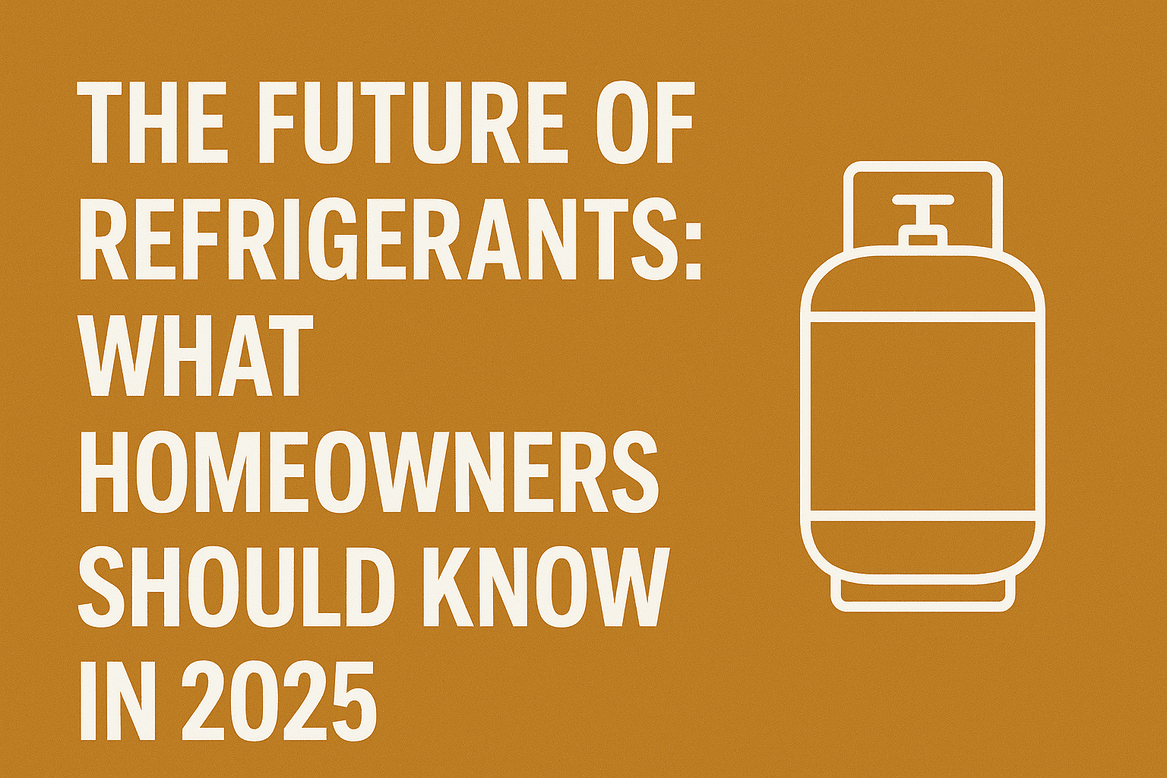The Future of Refrigerants: What Homeowners Should Know in 2025
Why the Refrigerant Landscape Is Changing
The HVAC industry is undergoing a significant transformation. Environmental concerns, regulatory mandates, and technological advancements are reshaping the types of refrigerants used in residential and commercial systems. As we move deeper into 2025, the shift away from high-global warming potential (GWP) refrigerants like R-22 and R-410A is accelerating. These changes affect homeowners directly, from system compatibility to energy efficiency and long-term cost savings.
The Phase-Out of R-22: What It Means for You
R-22 (Freon) was once the industry standard for air conditioning systems. However, due to its high ozone depletion potential (ODP), it has been systematically phased out under the Montreal Protocol. Since January 1, 2020, the production and import of R-22 have been banned in the U.S., Canada, and many other nations.
If your HVAC system still relies on R-22:
- You’re facing skyrocketing costs for recharging due to limited recycled supply.
- Replacement parts may become harder to find.
- It’s time to consider retrofitting or replacing the unit with a system compatible with modern, eco-friendly refrigerants.
The Rise of Eco-Friendly Alternatives: R-32 and R-454B
R-32 and R-454B are at the forefront of the new refrigerant wave. Both offer significantly lower GWPs and are now widely adopted in residential and light commercial systems.
R-32: A Transitional Leader
- GWP of 675 — nearly 70% lower than R-410A.
- Offers higher efficiency and cooling capacity.
- Used primarily in ductless mini-splits and some newer central systems.
- Mildly flammable (A2L), but safely manageable with proper installation standards.
R-454B: The Future-Forward Choice
- GWP of 466 — even lower than R-32.
- Approved by major manufacturers as the long-term replacement for R-410A.
- Starting 2025, many new residential HVAC systems will ship preloaded with R-454B.
- Like R-32, it’s A2L classified, but with industry-standard safety features in place.
Why R-410A is Also Being Phased Out
Though R-410A replaced R-22 in many systems, it is not a sustainable long-term solution. With a GWP of 2,088, it contributes heavily to global warming. Under the American Innovation and Manufacturing (AIM) Act, the EPA is enforcing a 40% reduction in HFC production and consumption by 2024 and 85% by 2036. This makes R-410A’s days numbered.
Energy Efficiency and Cost Benefits of New Refrigerants
Upgrading to systems using R-32 or R-454B brings significant cost savings over time:
- Lower energy bills due to improved thermal performance.
- Reduced environmental taxes or penalties.
- Enhanced system lifespan with modernized HVAC technologies.
- Eligibility for green energy rebates or tax incentives in several regions.
Refrigerant Safety: Understanding A2L Classification
Many new refrigerants are classified as A2L — mildly flammable but low toxicity. While the idea of “flammable” may raise concerns, it’s important to note:
- A2L refrigerants require very specific ignition conditions.
- Modern HVAC systems come with built-in safety protocols.
- Technicians are trained under updated ASHRAE 15 and UL 60335-2-40 standards to ensure compliance and safety.
Homeowners can feel confident in these new refrigerants when installation and servicing are performed by licensed professionals.
What Homeowners Should Do in 2025
1. Schedule a Refrigerant Check-Up
If your HVAC system is over 10 years old, it may still run on R-22 or R-410A. Ask your local technician to:
- Check the type of refrigerant used.
- Assess system health and potential leaks.
- Recommend whether retrofitting or full replacement is appropriate.
2. Upgrade to a Future-Proof System
Investing in a new high-efficiency heat pump or air conditioner using R-32 or R-454B ensures:
- Compliance with future regulations.
- Greater indoor comfort and air quality.
- Lower lifetime operating costs.
3. Choose a Contractor Who’s EPA-Certified
Always verify that your HVAC provider is EPA 608 certified and experienced in handling A2L refrigerants. This ensures your installation is:
- Safe
- Code-compliant
- Environmentally responsible
The Global Movement Toward Sustainable Cooling
Nations worldwide are committed to reducing their carbon footprints. From the European Union’s F-Gas Regulations to Canada’s HFC reduction strategy, the message is clear — low-GWP refrigerants are the future. Homeowners who act early will not only benefit from cleaner technology but also avoid future retrofitting costs and supply shortages.
What This Means for HVAC Technicians and Installers
Technicians must now be proficient with:
- Leak detection techniques for A2L refrigerants.
- New system diagnostics and smart HVAC controls.
- Retrofitting best practices for legacy systems.
- Compliance with building code updates regarding ventilation and equipment clearance.
Ongoing training and certification are non-negotiable for anyone in the HVAC trade.
Refrigerant Recovery and Recycling Programs
To support the transition, many governments and manufacturers offer recovery and recycling programs for outdated refrigerants. Homeowners can participate by:
- Turning in old units responsibly.
- Asking about rebate programs for green replacements.
- Ensuring that old refrigerants are reclaimed or destroyed properly, not vented into the atmosphere.
Looking Ahead: What Comes After R-454B?
Research is already underway to create next-generation refrigerants with even lower GWP, possibly under 10. Natural refrigerants like CO₂ (R-744) and Hydrocarbons (R-290, R-600a) may play larger roles in the future.
These options:
- Have ultra-low GWP.
- Require advanced system engineering.
- May become viable for residential use post-2030 as safety and affordability improve.
In Conclusion
The shift in refrigerant technologies is more than an industry change — it’s an opportunity for homeowners to make eco-conscious, cost-effective, and forward-looking decisions. Upgrading to systems that use R-32, R-454B, or other low-GWP alternatives ensures compliance, performance, and peace of mind.
Don’t wait for older systems to become obsolete — the future of cooling is already here.


